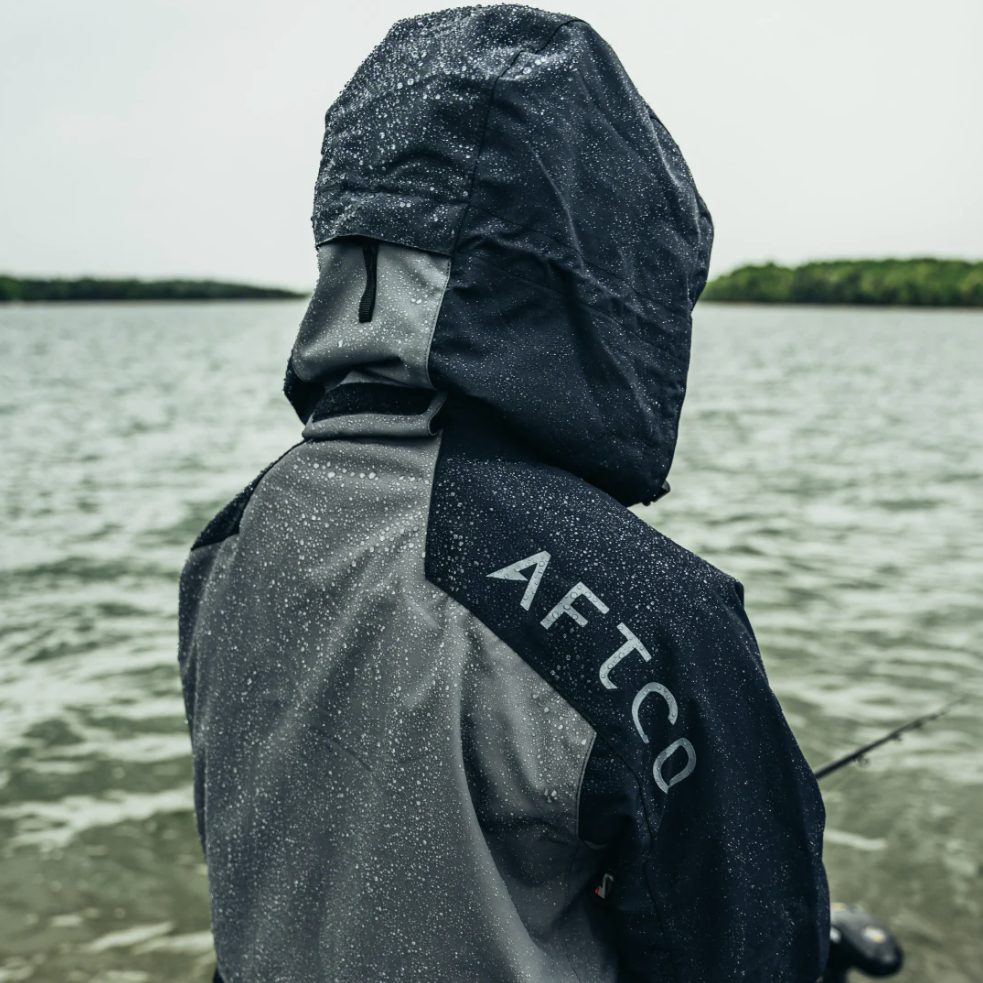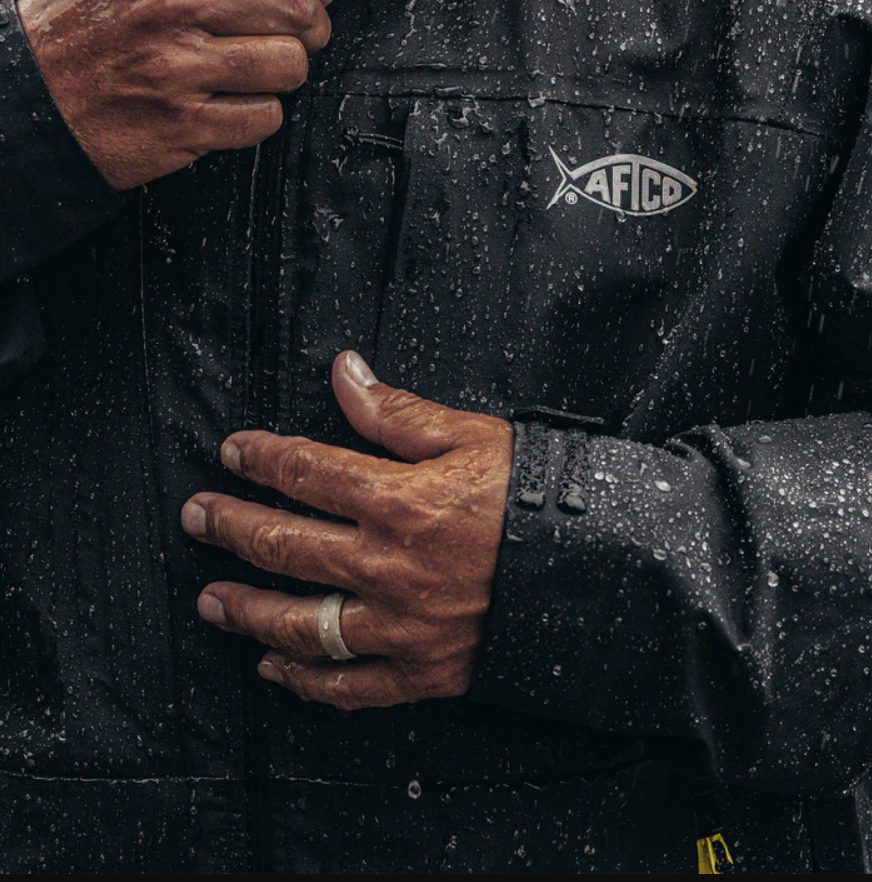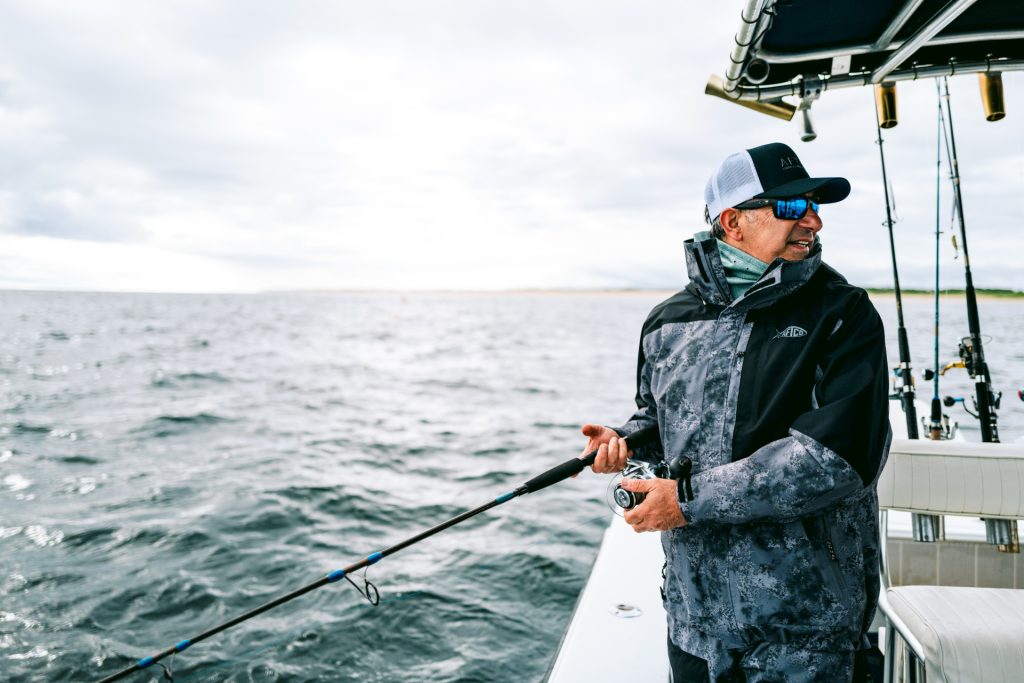There’s a big difference between a rain jacket that was made to get you from the truck to a grocery store door and one that’s made to keep you dry in a rain storm on the back deck in the middle of the Gulf of Mexico. Nothing puts the best rain gear for fishing to the test quite like a marine environment. In addition to whatever is falling out of the sky, you’re also dealing with the stuff coming over the sides of the boat. Wind gathers force coming across open waters, driving rain into you from all sides. As if all that wasn’t enough, once you fire up the engine and get underway, spray from the boat can drench you with each slap of the waves against the hull.
In an effort to learn more about what it takes to make rain gear that performs in demanding marine environments, we sat down with Jillian Hidalgo, AFTCO’s apparel Design Director. Jillian has extensive experience designing rain gear, having worked in both the fishing and motorsports industries, and was able to give us some information that can be used to compare the various types of rain gear out on the market to make sure that you end up with exactly what you need for a dry comfortable day out on the water, especially if we encounter some tropical conditions.
Fishing Rain Gear Factors To Consider
According to Jillian, the first question to ask yourself when shopping for fishing rain gear is, “What exactly will I be doing in these garments?”
“That right there is going to dictate a lot of choices,” she says. “We make rain gear for everywhere, from the warm Florida Keys to the guys up north ice fishing on frozen lakes. Different things are required in those different circumstances to stay comfortable out on the water, and that’s the end goal. The reason why you wear the foul weather gear at the end of the day is so that you can fully enjoy what you are doing. It’s not just about “surviving” a trip. It’s about keeping yourself comfortable so that you enjoy the day.”
Jillian continues, “Some of the questions you need to ask yourself before you buy are, ‘What season will I be fishing?’ ‘What type of fish am I looking for?’ ‘What temperatures am I expecting to be out in?’ ‘How long do I expect I’ll be out in precipitation, and what type will it be?’ ‘Is it going to be a torrential downpour, or just misty in the morning?’ ‘Is it going to be cold, or really windy?’”
“Those are all factors that you want to make note of when you are going to purchase something. If you’re an angler that fishes the Keys, and you just get some warm rain showers here and there, a 20K suit might work just fine because you’re just dealing with quick popup showers. On the flip side, if you’re going to be out for four to five hours in the rain in a colder environment like up on Lake Michigan, you’ll want a 30K suit.”
How Waterproof Is Your Rain Gear, Really?
Anybody who has been fishing for a while knows that there’s a big difference between clothing marketed as “water resistant” and “waterproof.” A garment advertised as water resistant is often just a regular old hoodie with an application of “Durable Waterproof Repellent,” or “DWR” coating applied to it. DWRs have their place in quality, waterproof clothing, but if you’re expecting anything more than the briefest of light drizzles, a DWR by itself is not going to keep you very dry.
On the opposite end of the spectrum are things like PVC or rubber. These materials are 100% waterproof for all intents and purposes, making them popular for boots, waders, and other materials that need to keep you dry when you’re submerged for long periods of time. But they have a big problem when worn as garments; they don’t breathe. At all!
Which brings us to the bread-and-butter technology in the word of technical rain gear: breathable, waterproof membranes. When shopping for breathable membranes, there’s a simple truth to keep in mind. The more breathable a membrane is, the less water resistant it is.

AFTCO and other makers of high-end rain gear offer a variety of membranes that offer more or less breathability and water resistance. To make sure you’re comparing “apples to apples” when shopping, Jillian stresses that anglers should look for the “K rating” of the clothing.
“In simple terms,” she says, “K rating refers to the meters per square inch of pressure water will have to be at in order to push through through the membrane. The higher that number, the longer it takes for the water to get through the membrane. Put even more simply, the K rating tells you how much rain it’s going to take to soak through that membrane.”
“Something like a 10K garment is going to get you through a very light rain for a small amount of time. 20K gets you higher resistance to heavier rain for a longer period of time. 30K is going to buy you even more time; a couple of extra hours in hard rain. But all membranes have a certain point where they become too saturated and water comes in. If you’re looking for something that’s 110% waterproof, you’re looking for a PVC product that has that rubberized coating on the outside.
There’s also usually a second K rating that can tell you how well a garment breathes or doesn’t breathe. The higher this second K value, the more pressure it takes for air to penetrate the fabric. A higher K rating here indicates less airflow through the garment, which isn’t great for breathability but means that the garment will keep you warm on high-speed boat rides or on days with brutal nor’easters.
Sealed Seams On Rain Gear
An often overlooked detail on rain gear is sealed seams. As Jillian explains, DWRs and high K rating membranes don’t mean much if a garment’s stitching isn’t protected.
“If you take a 30K garment, and you put a seam in it and you don’t seal it, you’re back at 0K,” she says bluntly. “If you have a sealed seam, you’re back to at least 20K in that area. And the thing is, seam sealing is actually really tough to do right. We work really hard with our factories because it’s really such an art. It’s a real human doing it, and they have to clip the fabric ends just right, and then roll it over carefully, and it has to have this beautiful, perfect bond on either side of the seam. And the quality of that seam really comes to the operator’s ability to be able to do that soundly and nicely. So we really choose our factories carefully, not just based on the quality of fit, but also how they seam seal, because that can make or break a garment.”
Best Rain Gear For Comfort
As Jillian mentioned, the purpose of rain gear is to keep you comfortable. We’ve talked a lot about water resistance and how to compare different rain suits out on the market, but water and wind resistance isn’t the only thing that makes a garment comfortable. How it fits is important too. With her previous experience in motocross, Jillian knows that the “perfect” fit looks different for different outdoor activities.
“Garment fit is an area that we’ve been working on for a long time, and our fit has evolved over time as we’ve gotten feedback from anglers,” she explains. “We’re moving towards a more articulated fit, but it’s different from a lot of the other stuff out there. It’s designed for a different type of movement. So, for instance, in a hunting scenario out west, you may be scrambling up scree, or crouching, or crawling…stuff like that. But if you’re fishing, you’re mostly standing, and it’s important that the garment moves with you as you do things like cast or climb up on casting towers.”

Jillian continues, “For a long time in the fishing industry, bigger and looser was better. But what we’ve found is that fit means more fabric to deal with that’s flapping in the breeze or catching a fish hook. So we’ve moved to a bit slimmer fit, but it’s not quite as thin as the stuff you see, say, KUIU or Sitka put out. It’s what I’d call a relaxed articulation, and it really layers better under outerwear and moves with you well.”
In addition to well thought out little features like the famous plier pocket that AFTCO first introduced on their shorts, Jillian mentions some other little features that are designed specifically with anglers in mind.
“The Speed Vent Hood is a real must-have on all of our foul-weather gear,” she says. “It’s a two part hood, so you have the full, high neck to shield off the weather, but then the hood is sewn in separately with these triangle back gussets so that when you do cinch it down and you are running a boat, it allows air to go through so it doesn’t blow off your head.”
“We also have the Double Dry Cuff, which was designed to keep water from running down your arm if you’re reaching up or casting. It also helps keep you drier if you have to dip your hand down into the water, like if you’re reaching to net a fish or scoop bait out of the livewell.”
“We actually have a picture,” she laughs, “that got taken during a design meeting where our president was sticking his hand down in a bucket of water and holding it up over his head to test which designs helped keep water out of your sleeve the best.”
Final Thoughts On The Best Fishing Rain Gear
Rain gear has come a long way from the heavy rubberized ponchos of yesteryear. There’s some pretty advanced chemistry behind the new DWR finishes and breathable membranes, and when those new technologies combine with good market research and good tailoring, it results in comfortable, practical, good-looking rain gear that can handle some of the world’s nastiest weather. But as we’ve learned from Jillian, not all rain gear is created equal. Hopefully, this article has left you with a good understanding of the commonly-used terminology in the industry, as well as a knowledge of how to read K Ratings and look for must-have features like sealed seams.




